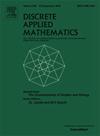On the tractability of defensive alliance problem
IF 1
3区 数学
Q3 MATHEMATICS, APPLIED
引用次数: 0
Abstract
Given a graph , a non-empty set is a defensive alliance if, for every vertex , the majority of vertices in its closed neighbourhood belong to ; that is, . The Defensive Alliance problem (Defensive Alliance) asks for a defensive alliance of minimum cardinality. The decision version of the problem is known to be NP-complete even when restricted to split graphs and bipartite graphs. From a parameterized complexity perspective, the Defensive Alliance is known to be fixed-parameter tractable (FPT) when parameterized by the solution size, the vertex cover number, or the neighbourhood diversity of the input graph. In contrast, the problem is W[1]-hard when parameterized by the treewidth or the feedback vertex set number.
In this paper, we investigate the complexity of the Defensive Alliance on bounded degree graphs. We prove that the problem is polynomial-time solvable on graphs with maximum degree at most 5 but becomes NP-complete when the maximum degree is 6. This result rules out fixed-parameter tractability with respect to the maximum degree. Additionally, we analyse the problem from the perspective of parameterized complexity and present an FPT algorithm parameterized by twin cover number, thereby resolving an open question posed in Gaikwad and Maity (2022).
论防御联盟问题的可追溯性
给定图G=(V,E),对于每个顶点V∈S,其封闭邻域中大多数顶点属于S,则非空集S是防御联盟;即|NG[v]∩S|≥|NG[v] + S|。防御联盟问题(defense Alliance)要求一个最小基数的防御联盟。已知问题的决策版本是np完全的,即使在分割图和二部图中也是如此。从参数化复杂性的角度来看,当通过解决方案大小、顶点覆盖数或输入图的邻域多样性参数化时,已知防御联盟是固定参数可处理的(FPT)。相反,当用树宽度或反馈顶点集数参数化时,问题是W[1]-hard。本文研究了有界度图上防御联盟的复杂性。证明了该问题在最大次为5的图上是多项式时间可解的,但在最大次为6的图上是np完全的。这个结果排除了相对于最大程度的固定参数可追溯性。此外,我们从参数化复杂性的角度对问题进行了分析,并提出了一种双覆盖数参数化的FPT算法,从而解决了Gaikwad和Maity(2022)提出的一个悬而未决的问题。
本文章由计算机程序翻译,如有差异,请以英文原文为准。
求助全文
约1分钟内获得全文
求助全文
来源期刊

Discrete Applied Mathematics
数学-应用数学
CiteScore
2.30
自引率
9.10%
发文量
422
审稿时长
4.5 months
期刊介绍:
The aim of Discrete Applied Mathematics is to bring together research papers in different areas of algorithmic and applicable discrete mathematics as well as applications of combinatorial mathematics to informatics and various areas of science and technology. Contributions presented to the journal can be research papers, short notes, surveys, and possibly research problems. The "Communications" section will be devoted to the fastest possible publication of recent research results that are checked and recommended for publication by a member of the Editorial Board. The journal will also publish a limited number of book announcements as well as proceedings of conferences. These proceedings will be fully refereed and adhere to the normal standards of the journal.
Potential authors are advised to view the journal and the open calls-for-papers of special issues before submitting their manuscripts. Only high-quality, original work that is within the scope of the journal or the targeted special issue will be considered.
 求助内容:
求助内容: 应助结果提醒方式:
应助结果提醒方式:


